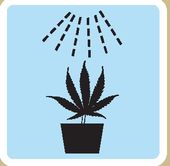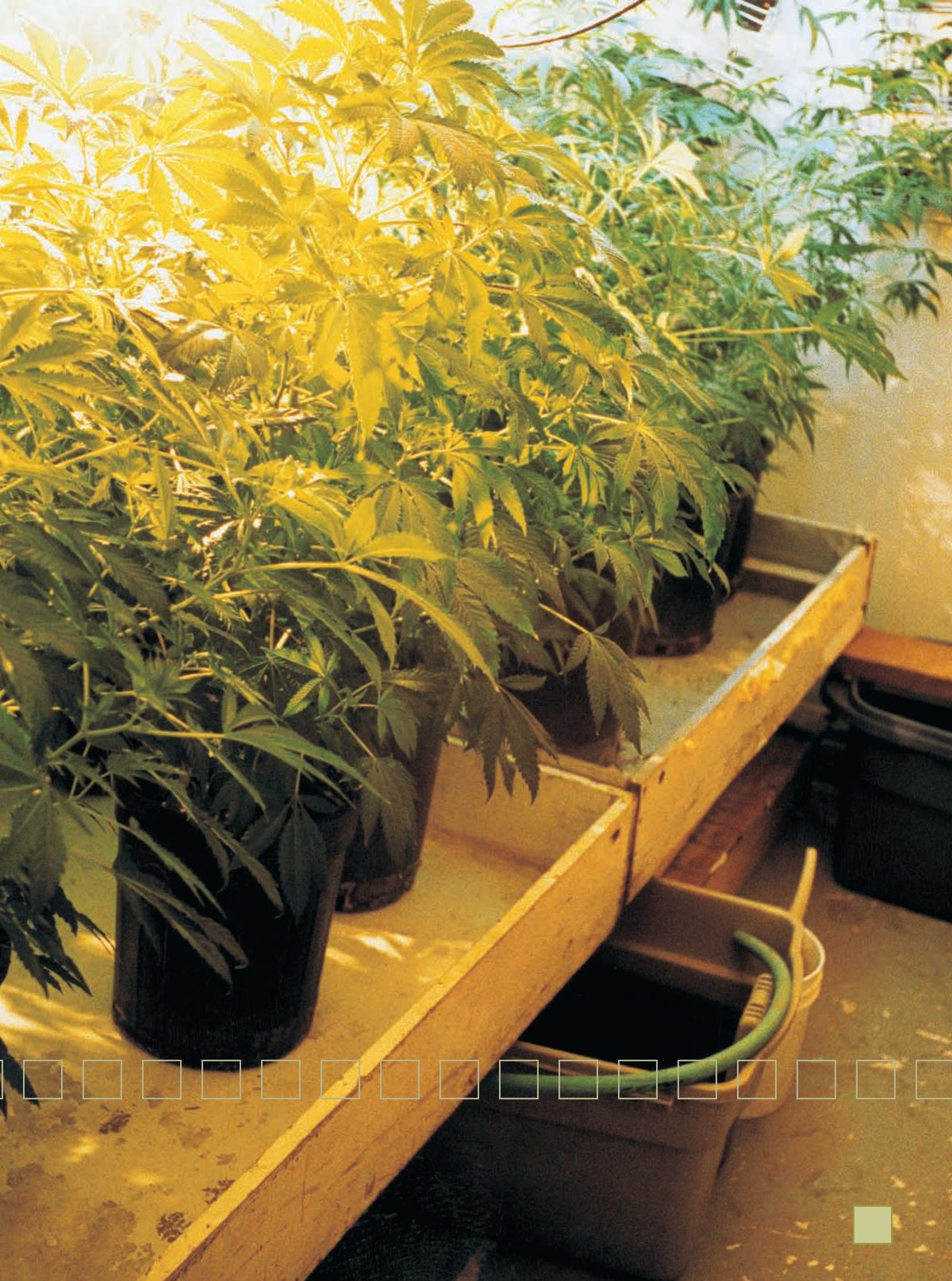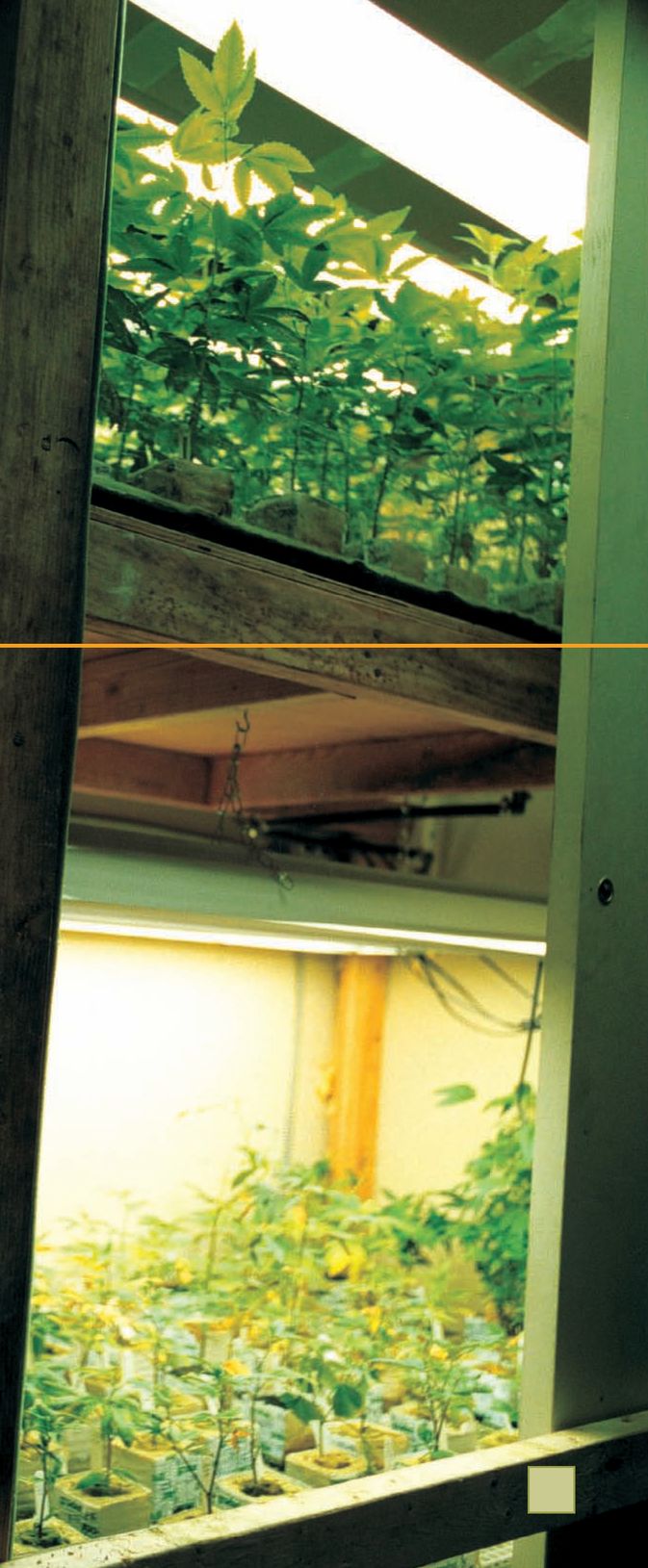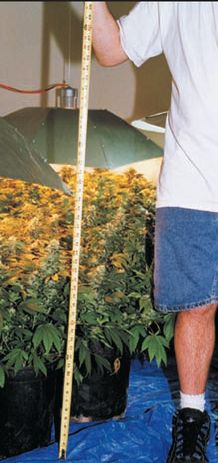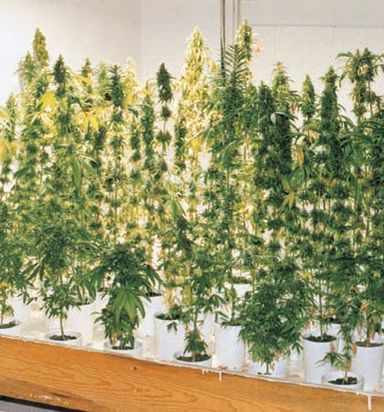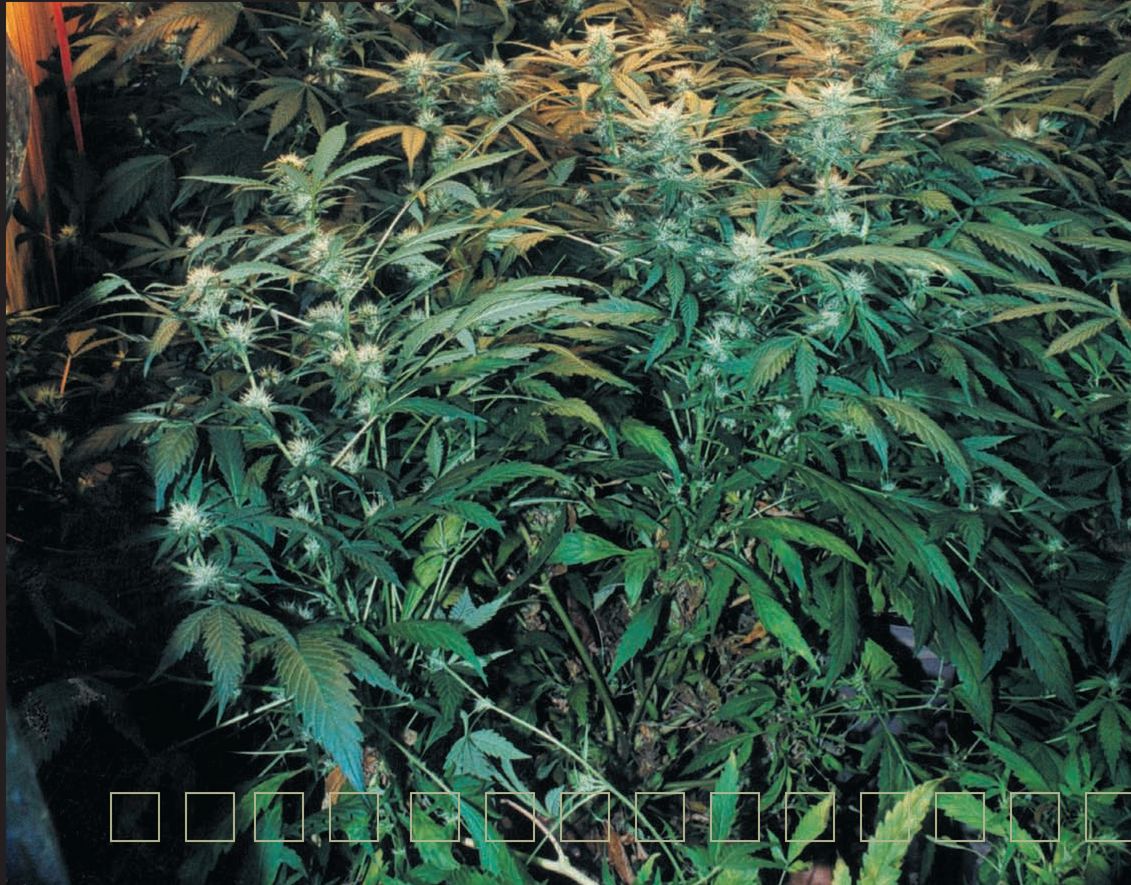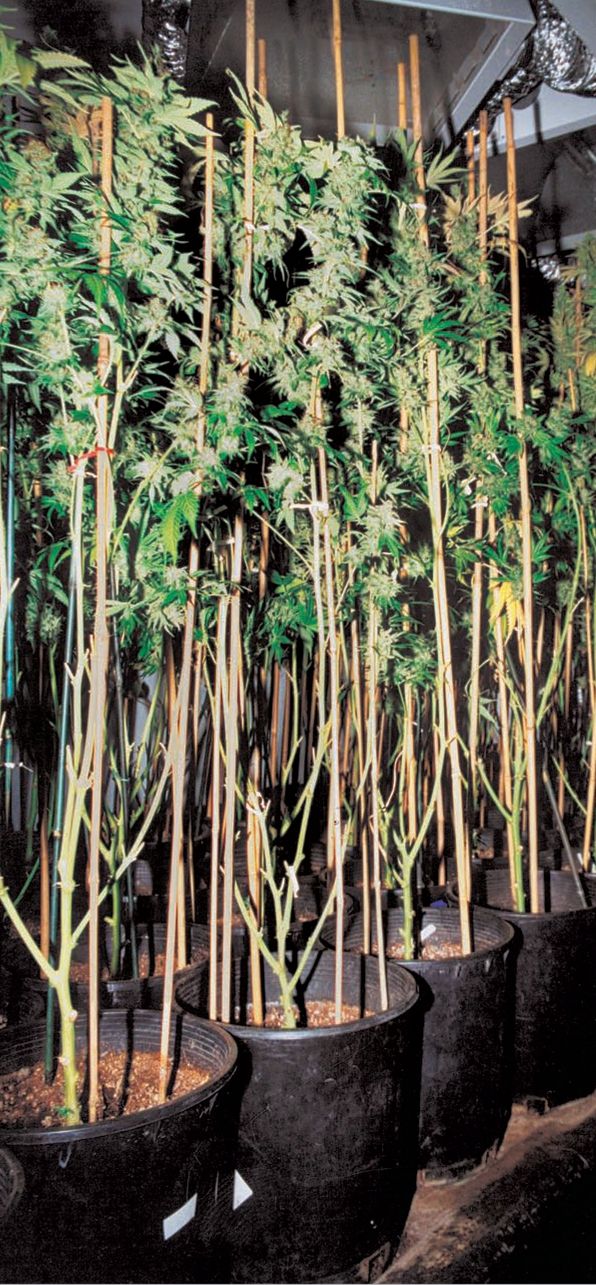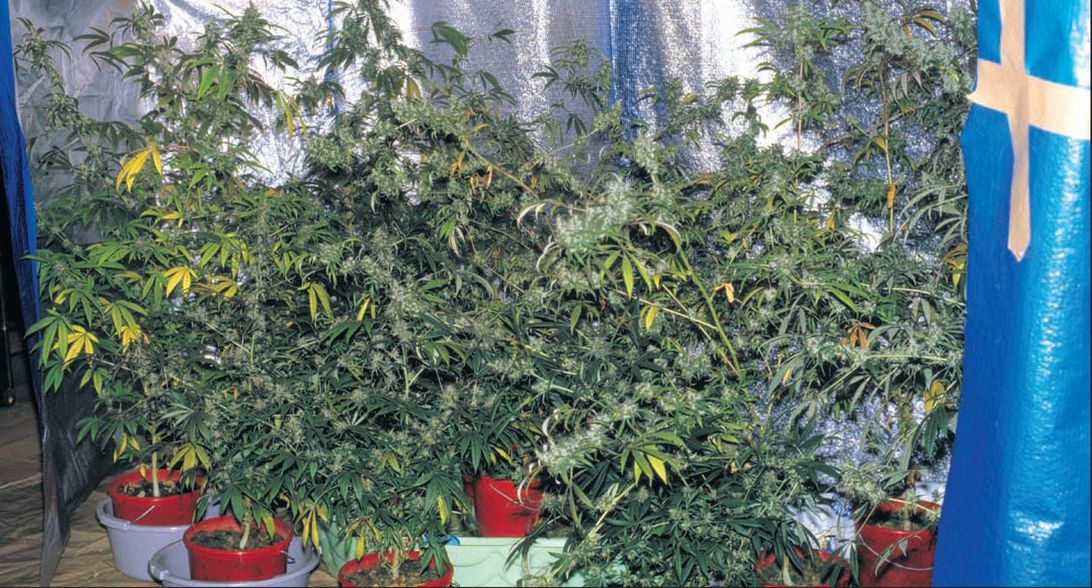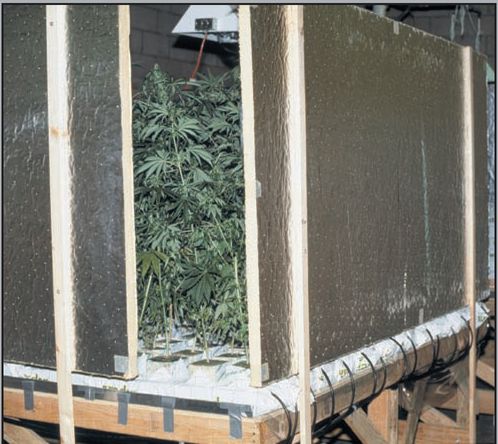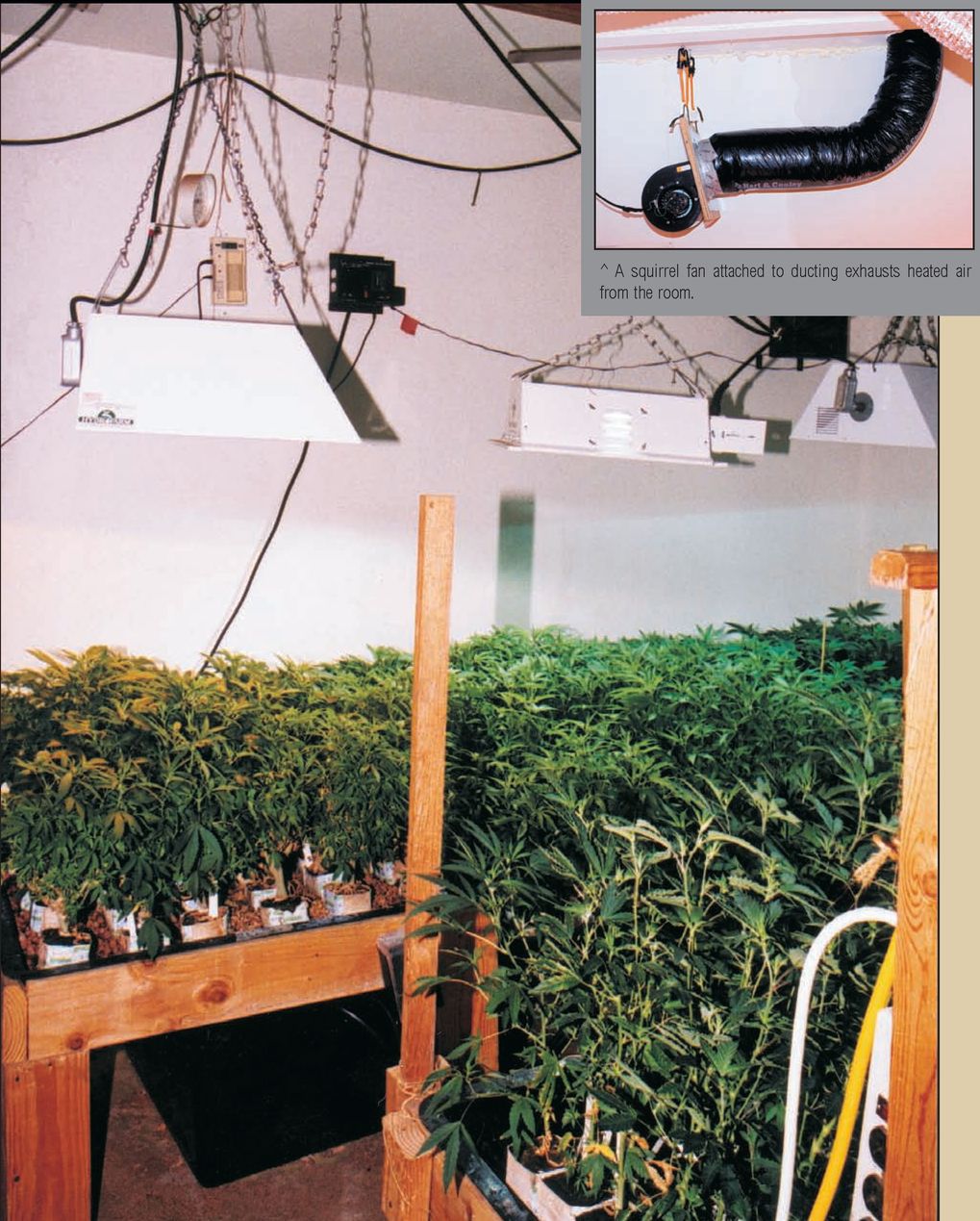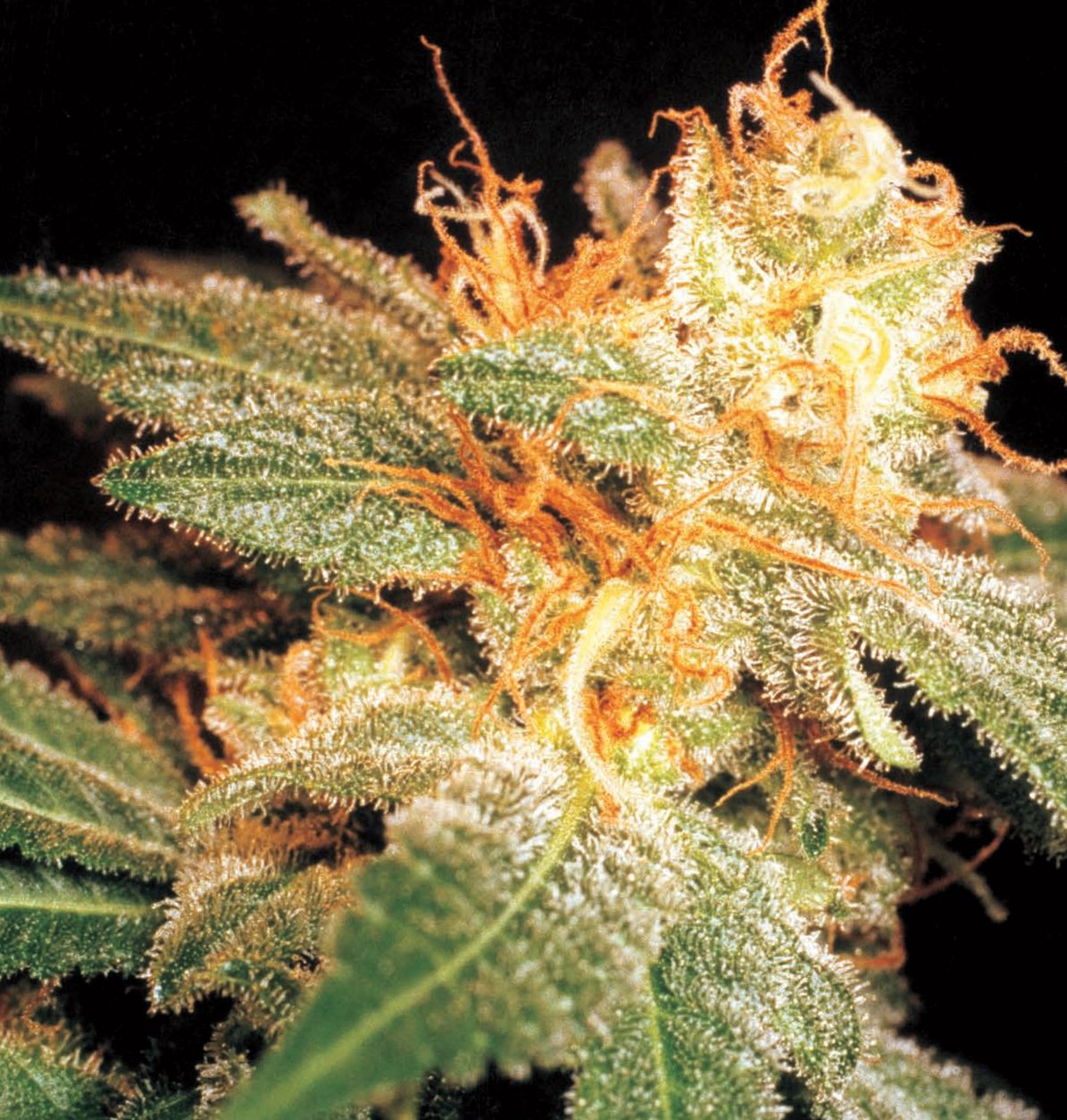Indoor Growing
This homemade tray was painted with plastic resin for waterproofing. The small room with a tray on either side was constructed in the basement. The plants were hand watered from the top. The water drained to the reservoir underneath.
Cannabis
Cannabis is an annual plant. Each spring the plant germinates and begins a period of rapid growth. As fall approaches, the plant’s growth changes from vegetative to flowering or reproductive.
Female and male flowers are found on separate plants. To produce seeds, pollen from male plants must fertilize the female flowers. When the male plants are removed from the garden, the females remain unfertilized. The resulting clusters of virgin flowers are called sinsemilla – Spanish for “without seeds.” These “buds” are prized by the marijuana connoisseur.
Undisturbed by gardeners, the male plants will release their pollen into the air, lose vigor and die. The female plants continue to produce flowers for quite a while as long as they remain unfertilized. Once fertilized, the small ovary found behind each flower begins to swell and within a few weeks, mature seeds are produced. When most of the flowers are fertilized, the plant ceases to produce new flowers. Instead, most of its energy goes to the maturing seed. As the seeds mature, the female plant also loses vigor and dies.
Varieties
There are thousand of varieties of marijuana. They have different potential yields, highs, flower sizes, bud structures, ripening times, heights, leaf shapes, colors, bushiness, and amounts of light required for adequate growth. In much the same way that environment affects the yield and flavor of grapes, it also affects the genetic potential of marijuana. The taste, quality of high, yield, and color are all subject to modification by the environment. Some of the factors include amount and quality of light, water, temperature, quantity, ratios and kinds of fertilizers or nutrients, and cultivation practices.
Breeders have been developing indoor varieties that are high-yield, potent and compact. For most gardeners, those commercial seeds or clones are the best choice. While the price of these seeds or plants may seem costly at first, getting the best seed stock is the most inexpensive way to improve a garden. No matter how good the system and care of the plants, if they do not have the potential for massive high-quality buds, they will never produce them. A seed does not represent just a single plant but an entire genetic line. New plants can be cloned from plants or more seeds can be produced which carry this heritage. The plant’s genes play the most important role in producing high-yield, potent marijuana. Seeds from mediocre bud are likely to produce more of the same poor quality bud.
Many companies advertise seeds on the Internet and in magazines. They feature excellent varieties with many admirable characteristics. Another way of obtaining good varieties is by using clones. A clone, made from cuttings taken from a known, high-quality mother, is an exact genetic duplicate of the plant from which it is taken. They are the easiest way to start a garden because they are already selected for quality and have been sexed. Seeds produce plants that vary in quality and must be sexed.
The goal of the grower is to cultivate a garden of healthy, vigorous, fast-growing plants that will live up to their genetic potential. Indoor marijuana farms are limited spaces that should be used as efficiently as possible. To do this, the plants should be induced to flower while they are still short – saving space, time and energy.
To get the highest yield, gardeners grow many small plants rather than a few large ones. Smaller plants yield more per square foot of space, mature faster, and are easier to care for than large ones. Imagine a garden with a few large plants: each plant takes quite a bit of time to fill the space they are allotted. If the same space were planted with many small ones, each plant would have to grow only a little to fill the canopy.
People used to think that size or age was important, but they soon found that maturity or ripeness is more crucial. As the buds on the plants ripen, their potency increases. Whether a plant has been growing for several months or a few weeks before it is forced to flower, it will have the same potency when the flowers ripen.
Plants that are flowered when they are small have little chance to develop side shoots. The result is that each plant uses less vertical space and a smaller area, and can therefore be placed closer together. When plants are forced to flower before they have grown more than ten inches tall, they use even less vertical space. Gardeners often find it convenient to divide the growing area into several levels of shelves to double the harvest potential.
Perspective
Both set-up and maintenance of a successful indoor garden require a bit of work and some hands-on experience. Rather than setting up a gigantic, sophisticated garden without experience, it is best to start off with a less ambitious project for a greater chance of success. There is a learning curve to follow before getting your garden running at full potential. As any farmer will tell you, “Don’t count your chickens before they hatch.”
Small gardens with one or two 1000-watt lamps are easier to maintain than large ones. They take less time but, more importantly, they do not have the problems of energy consumption, ventilation and heat that large gardens do. As we will discuss later on, lights are the biggest contributors of heat to the garden. Some of this heat can be eliminated before it gets into the garden using air-cooled lights. The heat created in a small system is easily dissipated into the surrounding environment, especially during the cool months. By comparison, a large operation requires a more sophisticated heat-exchange system.
Lighting
Cannabis has two distinct parts to its growing cycle. First it grows vegetatively and then it goes into flowering. During the vegetative cycle, plants should receive light for a minimum of 18 hours a day, but they grow faster with continuous lighting. The vegetative cycle has several purposes. Seeds are germinated under the vegetative regimen and mother plants, which have been selected to make clones, are kept growing. Cuttings are taken from the plants periodically. The cuttings, which are turned into rooted clones, are also grown under 18-24 hours of light. Once the clones are planted they may be grown vegetatively for a week to a month, until they reach sufficient size to force flowering. The seeds, mothers and clones should be placed together in a separate space. It doesn’t need to be large since it is used mostly for maintaining a few mother plants and starting seeds and clones.
Marijuana is a short-day plant, meaning that flowering is induced when the plants receive only 12 hours of light. They measure the uninterrupted dark period using a hormone that is produced continuously but is destroyed in the presence of light. It accumulates during the dark period and reaches a critical level at around 12 hours. When this hormone reaches a critical level several days in row, the plants change their growth from vegetative to flowering. For this reason it is important never to interrupt the dark period. The hormone is neutralized and hormone accumulation starts all over. Once the plants get to the desired size for flowering, the lights are turned down to 12 hours.
This clone room was built on two levels in a twocar garage. The small clones were placed in four-inch rockwool cubes for finishing into “starters” that were ready to grow in the flowering room.
Both set-up and maintenance of a successful indoor garden require a bit of work and some hands-on experience. Rather than setting up a gigantic, sophisticated garden without experience, it is best to start off with a less ambitious project, with a greater chance of success.
Sativa remnants of a reservoir garden in an attic. Reflective plastic was strung on rope tied to beams to create a space. Plants were grown in a mix of vermiculite, perlite and planting mix, and hydrated from the bottom by pouring in two inches of water. The planting mix absorbed it within a day. The plants were watered about every five days. This garden worked well during the fall, winter and spring, but was closed down during the summer due to heat problems. A small gas heater kept the plants cozy and warm in a high CO2 environment. The five-foot diameter pool was lit using a single 1000-watt HPS lamp.
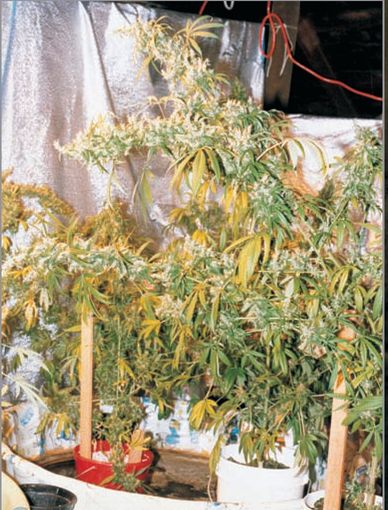
To produce good buds that are dense and filled with sparkling resin glands, the garden requires a minimum of 35 watts of electrical light input per square foot. The buds grow denser and more potent when the plants are supplied with an electrical input of about 65 watts/sq.ft. At a higher intensity a 1000-watt lamp lights an area of about 16 square feet. A 4’ x 8’ table is illuminated using two 1000-watt lamps. A 1000-watt high pressure sodium (HPS) lamp is the most efficient to use, producing the most light useable by the plant for photosynthesis. Plants use light in the blue and red spectrums to power the process. Although some store owners and books insist that metal halide (MH) lamps are best for vegetative growth because they produce a whiter light, controlled experiments have proven that plants grow faster under HPS lamps than under MH lamps.
Light fixtures and reflectors can hang from chains mounted directly on a stud, or using a molly bolt into the lathing. The lamp’s height is adjusted by changing its position on the chain. It is extremely important for the light to be hung securely. Should the reflector fall, it could cause an electrical short in a wet area, which is very dangerous, even life threatening. Gardens should be equipped with a circuit breaker, which will shut off the power in case of a short or an interruption of service. Each garden space should also house a conveniently located fire extinguisher for electrical fires.
The Floor
The floor of the grow room should be protected from water using heavy plastic lining, especially with a wooden floor or linoleum tile surface. If the grow room is in a basement or a room where the temperature of the floor is always cool, either the surface should be insulated or the plants should be raised off the floor. This is very important because cold floors draw heat from the containers. Plants germinate and grow considerably slower when their roots are cold. There are a number of ways of insulating including Styrofoam insulation, which comes in sheets or rolls. This material has the added advantage of being very reflective, so that any light hitting the surface will bounce back to the plants. Plywood can also be placed over a layer of insulating material.
If the grow room is in a basement or a cool room, where the temperature of the floor is always cool, either the surface should be insulated or the plants should be raised off the floor.
Reflectors
Not all reflectors are the same; some are more efficient and deliver more light to the garden than others. Horizontal reflectors deliver more light than reflectors that hold the bulb vertically. The large parabolic reflectors are often poorly designed resulting in light being directed to walls rather than the garden. Several brands have premium reflectors that have special finishes and CAD inside reflectors.
The Space
Gardeners have converted all kinds of spaces to grow rooms: closets, small rooms, pantries, basements, attics and sheds. The space must be high enough to allow the plants to grow to three feet. A space five feet high can be converted into a single garden, while a space ten feet high can be converted into a twolevel garden. The area that a space covers is calculated by multiplying the length by the width; the result is the number of square feet. The size and number of lights used is based on the total area.
When the garden is configured, aisle space should be left between the plants, so that they can be attended to easily. People have an effective reach of two to three feet, so aisles are usually 18 inches to two feet wide. A four-foot wide grow space that can be reached from either side is an ideal width.
Plants can be raised off a floor using a table, wooden boards or shipping pallets. Providing air spaces that surround the plants’ containers with room temperature air is crucial. Roots can also be kept warm using a heating cable or heating mat made for heating soil or containers. Some cables and mats have a built-in thermostat to keep the temperature at a constant 70ºF-75ºF. Heating cables and mats are available from many garden shops, are convenient to use and consume only a few watts. Water used to irrigate the plants should also be warmed to room temperature so that the roots are not shocked and cooled down. Tap water should be lukewarm and water held in a reservoir can be warmed using an aquarium heater and thermostat.
CO2, Heat and Ventilation
Previously, we discussed that plants use light energy to convert airborne carbon dioxide (CO2) and water (H2O) into sugar. For you math heads out there, the formula is 6(CO2)+6 (H2O)+Light=C6H12O6+3(O2). The amount of light helps in determining the growth rate and yield; other factors are nutrients, adequate water, temperature and the amount of CO2 available to the plant. In indoor gardens, ideal levels of water, nutrient availability and temperature are all easy to control. More difficult to control are factors related to the air quality – CO2, temperature, humidity and ventilation.
This bedroom was converted into a grow space with the addition of lights and plants. The vertical parabolic reflectors are very inefficient because they are shallower than the bulb. As a result, much of the light is lost to the side walls. The plants were forced to flower when they were only eight inches tall. The indica variety grew another 4 inches and was 12 inches tall at maturity, only 10 days after this photo was taken.
These plants were grown in 32-ounce Styrofoam cups in a homemade tray. The plants were forced to flower when they were only 10 inches tall. Once they were forced they stopped growing branches.
The right wall of this space is covered with aluminum foil. The left wall is made from plywood installed to create a 2 1/2-foot by 12-foot space in the living room. The new wall was built to the ceiling so that it blocked all light as well as odor from getting to the other side. There was access to a window for ventilation. The 30 square-foot space was lit using a 400-watt metal halide and a 600-watt HPS lamp. The living room side of the wall was decorated with store-bought drapes.
These plants were pruned to four branches per plant. Each branch was staked so that it would stand upright and receive its share of the light.
CO2 is an odorless gas, slightly heavier than air, that comprises about .035% of the air or about 350 parts per million (ppm). Plants use it as an ingredient in photosynthesis. When the plants are brightly lit and all other conditions are met, the amount of CO2 in the air directly affects the rate of photosynthesis. Photosynthesis slows as the amount of CO2 drops and virtually stops when the amount goes down to 200 ppm, not resuming until the amount rises again.
Conversely, under brightly lit conditions, photosynthesis speeds up as the rate of CO2 rises. As the CO2 in the air increases to .2% (or 2000 ppm) the plants continue to increase their growth rate and yield. The best way to regulate the supply of CO2 to the garden is by using a small tank that holds 20 pounds of the compressed gas, controlled by a system that continuously measures the amount of CO2 in the air and regulates a valve to keep the desired level. The plants use CO2 only during lit hours and cannot store it, so the gas should only be on during the lit periods. It is used throughout the growing cycle in both vegetative growth and flowering.
When it comes out of the tank, CO2 is heavier and cooler than air. The dissolved gas will evenly distribute itself into another gas, gradually dispersing from the rich air to the air with less CO2. For this reason the room should be kept as tightly sealed as possible.
However, when the garden is sealed a problem results from lights heating the space, as mentioned earlier. If heat can’t be removed the plants will get too hot, resulting in skimpy loose buds that never reach full potency. There are many ways to cool your space: ventilating hot air out and cool air in with fans, portable and window air conditioners, foggers, and swamp coolers in dry areas. Some of the heat problem can also be solved using air-cooled lights. The reflectors hold a pane of glass. Four-inch duct tubing is secured to a male adaptor around holes on either side of the reflector. A fan blows air into the duct from another space and the outgoing tubes vent the heated air outside the space. Up to four lights can be set up in series with fans at both ends of the system. The heated air has no odor because it has been enclosed in the tubes. It can be vented out or used to heat a cool space. This process eliminates about half the heat.
Some gardeners use powerful ventilator fans to keep their garden cooled. During warm weather they use swamp coolers in dry areas and air conditioners in humid areas. They forego the benefits of CO2 enrichment but supply their plants with fresh air containing adequate levels of the gas.
Humidity can be another problematic factor. Humidity greater than 50% is an invitation to molds and other infections. Dehumidifiers can be used to control high humidity and air conditioners also remove water from the air as it is cooled. Mini-computers are available which automatically regulate heat, temperature, humidity and CO2. They can be programmed to turn on the dehumidifier when it gets too humid. The CO2 stays at a set ppm of 2000 during the light periods. The window air conditioner is turned on when the space hits 80ºF. The ventilator exchanges the air once an hour. The CO2 is turned off while this is happening and then the unit is turned back on, enriching the air after the exchange is complete.
A warehouse space was enclosed with silvered plastic taped to a frame built from PVC pipe. There was plenty of ventilation in the drafty space. Hot air rose to a 30-foot ceiling. An oscillating circulation fan (upper left) helped keep the air moving. Plants were hand watered. The trays caught excess water, which was eventually absorbed by the planting medium. A few simple improvements in the system would have produced a higher yield. The vertical metal halide light should be replaced by a conversion HPS lamp in a horizontal reflector. The plants should have been pruned and staked.
Planting Medium
The easiest way to get started is to buy a high-quality potting soil that is enriched with nutrients and use it to fill 6- to 12-inch diameter containers. The clones or seedlings will be planted in these containers where they will spend both their vegetative and flowering cycles. A high-quality growing medium will support the plants with nutrients during the vegetative cycle. Each region of the continent has its own high-quality brands. Check with a nursery or with growers who are familiar with the different brands.
A 6-inch container filled with high-quality planting medium supports a plant’s growth for about ten days. A 12-inch container will support the plant for about a month – approximately the same amount of time the plant should grow vegetatively before it is forced to flower.
This garden grew on a custom built 8’ x 8’ table. Three-inch rockwool cubes were placed on eight-inch wide, 2 1/2-inch thick rockwool slabs. Three 1000-watt HPS lamps in horizontal reflectors on a three-arm light mover were used to light each table. Moveable light reflectors were constructed from two-inch rockwool board and one-by-twos. At first the Styrofoam was covered with Mylar, but was later uncovered to reflect more light back to the garden.
A planting medium without nutrients added will never support plant growth by itself; it needs fertilizers to provide essential nutrients. The easiest way to provide these is by using a water-soluble fertilizer.
Fertilizers
Hydroponic fertilizers work well for both vegetative growth and flowering, but soluble houseplant formulas can also be used. During vegetative growth, plants in non-enriched mediums need a “growth” formula with near equal amounts of nitrogen (N), phosphorous (P), and potassium (K), as well as secondary- and micro-nutrients. All fertilizer packages list guaranteed minimum N-P-K levels, always in that order.
During flowering, the plants should be fertilized at each watering with a flowering formula fertilizer that has a higher amount of phosphorous than the other nutrients. It should also list micronutrients on the package. A safe but effective fertilizing method is to use the fertilizers at half-strength each time the plants are watered, usually about twice a week.
One way to grow organically is to use guano, kelp meal and rock dust. For the vegetative growth stage use the following for each gallon of water:
1/2 tblsp. guano with a fertilizer ratio of 10-3-1
1/2 tblsp. guano with a fertilizer ratio of 3-10-1
1 tblsp. kelp meal or concentrated kelp extract
1 tblsp. rock meal with a high potassium rating
(usually about 0-0-3).
Boil water, add the ingredients and let simmer for 15 minutes. This helps dissolve the nutrients. It also creates an offensive odor. Add this concentrate to the rest of the water before irrigating the garden.
For flowering, the formula is changed to 1 tablespoon of the 3-10-1 formula. These nutrient formulas should be used once a week. They will provide the plants with a healthy mix of nutrients and minerals.

A vertical reflector hangs from a chain attached to a light mover. This vertical reflector covers the length of the filament so that light is deflected downward to the garden rather than to the walls. The light mover travels across a six-foot track so that all portions of the garden receive intense light. A round trip on the track takes about seven minutes. The height of the lamp is easily adjusted by changing its position on the chain.
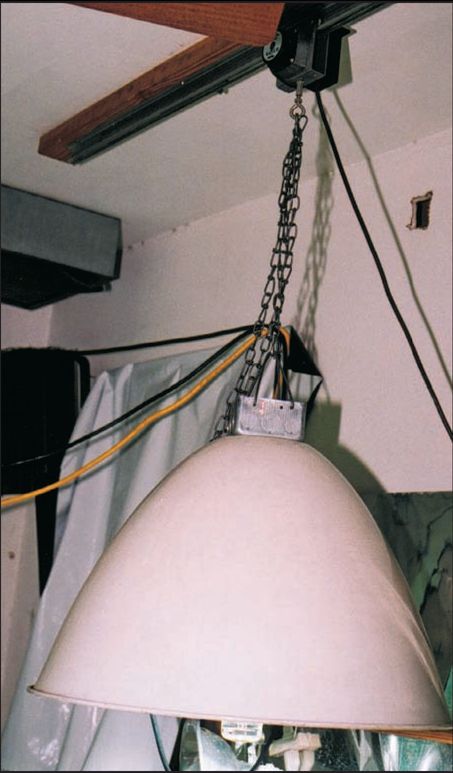
A garden using ebb-and-flow systems. The plants were grown in three-inch cubes and placed on rockwool slabs. Clay pellets were placed over the slabs to prevent algae build-up. The surface of the pellet dries out so algae will not grow. The CO2 unit in this room is controlled by a sensor (cream-colored box over the left light), which signals the regulator (black box to the right of the left light). When the CO2 level falls below 1600 ppm, the natural gas burner connected to the building’s plumbing turns on. Burning the gas produces CO2, water vapor and heat.
You have a choice; hydro or soil. Why not take the easy way out?
Jack bud 11 1/2 weeks after forcing flowering. The glands are tightly spaced all over the flowers and small leaves. Their tips have inflated into mushroom-like crowns. The stigmas have dried and turned bright orange and receded partly into the swollen ovaries behind the stigmas. This flower is ripe.


